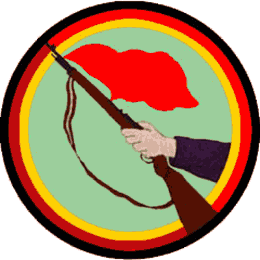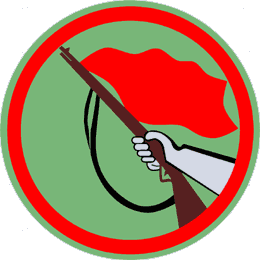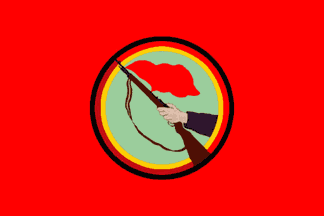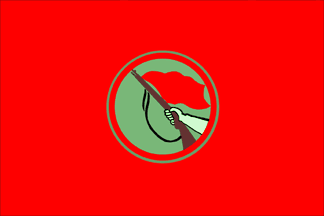 1953 version
1953 version
 1973 version
1973 versionImages by Jens Pattke and Volker Moerbitz Keith

Last modified: 2013-03-23 by pete loeser
Keywords: east germany | german democratic republic | fighting groups of the working class | kampfgruppen der arbeiterklasse | disc (green) | firearm: rifle | flag (red) |
Links: FOTW homepage |
search |
disclaimer and copyright |
write us |
mirrors
![[Fighting Groups of the Working Class (East Germany)]](../images/d/de}kga.gif)
 Image by Volker Moerbitz Keith/Modified by Jens Pattke
On this page:
Image by Volker Moerbitz Keith/Modified by Jens Pattke
On this page:
This para-military organization was somewhat like a National Guard but under strict control of the ruling party. Each large factory hat its own armed Fighting group troops to defend the property of the people. This was a voluntary service with the benefit that members of the task forces were not drafted for army reserve drills.
Volker Moerbitz Keith, 24 January 2001
This was not Civil Defence. These Groups were some kind of paramilitary forces, which in case of an emergency would join the regular military forces and the police. Such an emergency was not meant to be any weather condition...
Dirk Schönberger, 26 January 2001
The Kampfgruppen were a voluntarily organization with a clear military task, which was to defend home territory. They were organized like infantry units and incorporated in the strategic planing of the National Defense Committee. Their most visible appearance was on August 13, 1961, when they stood in first line, when the Berlin Wall was built. As far as response to disasters is concerned, there were two other organizations, the Zivilverteidigung (Civil Defense) and the Bereitschaftspolizei (Riot Police).
Volker Moerbitz Keith, 6 February 2001
The Fighting Groups of the Working Class, or Combat Groups of the Working Class (Kampfgruppen der Arbeiterklasse), was a paramilitary organization in East Germany, founded in 1953 and abolished in 1990. It numbered about 400,000 volunteers for much of its existence. The Kampfgruppen were formed on September 29, 1953 after the workers' uprising of June 17, 1953.
More information can be found (here) on Wikipedia.
Jens Pattke, 18 March 2013
[Editorial Note: The German name Kampfgruppen can be translated as "Combat Groups", "Battle Groups", or "Fighting Groups". I have chosen to go with using "Fighting Groups" on this page. The abbreviation KdA was never used for the Fighting Groups, but if an abbreviation was to be used, then based on the patriotic education-lessons (Staatsbürgerkunde), the abbreviation would be something like "KG d. AKL". However, it was never used this way in East German newspapers and books.]
 1953 version
1953 version
 1973 version
1973 version
Images by Jens Pattke and Volker Moerbitz Keith
The Fighting Groups emblem showed a hand, holding a rifle with a red flag attached to the barrel. The emblem was usually centered on a red flag and shown at parades and in Fighting Groups camps. Source: German Democratic Republic propaganda website (image here).
Volker Moerbitz Keith, 24 January 2001
It should also be noted that the Kampfgruppen emblem was also subject to the tastes of the time. Therefore, there are many variations. In the 1950s, these flags were individually hand-made and craftsmanship played a big role. Therefore, this explains the diversity. Sometimes, the Kampfgruppen emblem was simplified, as shown in the design of Volker's version. Notice in the 1953 logo the sleeve of the hand is dark blue and the emblem is bordered by rings in the German colors of black-red-yellow. In the 1973 logo the sleeve of the hand is celeste (or silver) and it is bordered by a broad red ring and narrow light khaki circle.
Jens Pattke, 18 March 2013
 Image by Jens Pattke, 17 March 2013
Image by Jens Pattke, 17 March 2013
The first Kampfgruppen flag (1953) was on red cloth with the Kampfgruppen symbol on a light khaki circle with a dark blue arm (holding a dark brown rifle with a red flag attached to the barrel); surrounded by a ring in German colors, black-red-yellow.
Jens Pattke, 17 March 2013
 Image by Jens Pattke, 17 March 2013
Image by Jens Pattke, 17 March 2013
The symbol was changed in 1973. On the occasion of the 20th Anniversary of the Kampfgruppen were given a new emblem. The ring in German colors was replaced by a broad red ring. The red ring symbolized the working class. The national connection with Germany was lost.
Jens Pattke, 17 March 2013
This flag is the Truppenfahne (Troups colours). Battalions, Groups of Hundreds, and Platoons all used this Truppenfahne. The regulation VD-W-O 1802/85 regulated the form and use of the Truppenfahne. The regulation was issued in 1985. It was the last regulation of a Truppenfahne of the Fighting Groups of the Working Class issued.
A red flag with the Kampfgruppen symbol in the center (on a khaki circle) with a celeste arm holding a brown rifle with a red flag attached to the barrel; it was surrounded by another khaki ring with the white words -FÜR DEN SCHUTZ- DER ARBEITER- UND BAUERNMACHT- (For the protection of the power of the workers and farmers). Surrounding the whole ring was a silver oakleaf wreath. The flag sometimes had a Silver fringe.
Jens Pattke, 17 March 2013
A Platoon (Zug) consisted of two or several Groups (Gruppen). A red flag with the Kampfgruppen symbol on the center - on a khaki circle a celeste arm (holding a brown rifle with a red flag attached to the barrel); surrounded by a khaki ring with the white words -FÜR DEN SCHUTZ- DER ARBEITER- UND BAUERNMACHT- (For the protection of the power of the workers and farmers), surrounding the ring a silver oakleaf wreath. On the canton, the military name of the unit in white lettering (here, 34. KAMPFGRUPPEN-ZUG (mot.) STRAUSBERG, Strausberg being a city in Brandenburg).
Jens Pattke, 17 March 2013
A Fighting Groups of a Hundred (Hundertschaft) had a red flag with the Kampfgruppen symbol in the center of a khaki circle with a celeste arm (holding a brown rifle with a red flag attached to the barrel); surrounded by a khaki ring with the white words -FÜR DEN SCHUTZ- DER ARBEITER- UND BAUERNMACHT- (For the protection of the power of the workers and farmers), all of which was surrounded by a silver oakleaf wreath. On the canton, the military name of the unit in white lettering (On this flag:
162.KAMPFGRUPPEN-HUNDERTSCHAFT WEISSWASSER, Weißwasser being a city in Saxonia, near Poland).
Jens Pattke, 17 March 2013
The colours of a Fighting Battalion (Bataillon) was a red flag with the Kampfgruppen symbol in the center of a khaki circle with a celeste arm (holding a brown rifle with a red flag attached to the barrel) surrounded by a khaki ring with the white words -FÜR DEN SCHUTZ- DER ARBEITER- UND BAUERNMACHT- (For the protection of the power of the workers and farmers). It was all surrounded by a silver oakleaf wreath. On the canton, the military name of the unit in white lettering (Shown here: I. KAMPFGRUPPEN-BATAILLON BERLIN, stationed in East Berlin).
Jens Pattke, 17 March 2013
Generally, the groups did not use troop flags. The Groups used the general flag of Kampfgruppen (A red flag with the Kampfgruppen symbol in center: on a khaki circle, a khaki arm, holding a brown rifle with a red flag attached to the barrel). A group unit was the smallest military unit of the Kampfgruppen. The unit consisted of the Fighting workers of a factory or a cooperative.
Jens Pattke, 17 March 2013
On this unusual Kampfgruppen was added the words Betriebskampfgruppe VEB Halbleiterwerk Frankfurt (Oder) (Fighting Group of the Factory for Microelectronics in Frankfurt (Oder)) in the canton.
Jens Pattke, 29 December 2001